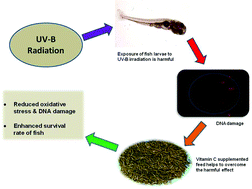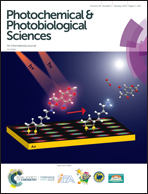Dietary supplementation of vitamin C: an effective measure for protection against UV-B irradiation using fish as a model organism
Abstract
The development of UV-B protective mechanisms in aquacultural species is essential for the sustainable production of healthy aqua crop. Freshwater carp Catla catla larvae (13.5 ± 1.12 mg) were fed with a diet containing 0.5% vitamin C (D1) and a control diet (D2) for 40 days. Each group was exposed to two doses of UV-B irradiation: 360 (5 min, D15 min and D25 min) and 720 mJ cm−2 (10 min, D110 min and D210 min) for 15 days. Significantly (p < 0.05) higher survival and average weight were recorded in D1 compared to D2 exposed to the same dose. Also, significantly (p < 0.001) higher nitric oxide synthase and lower thiobarbituric acid reactive substances and heat shock protein 70 levels were recorded in D15 min compared to the other groups. A direct relationship was found between the dose of UV-B and DNA fragmentation in muscles. DNA damage indices such as tail DNA, tail extent moment and olive tail moment were significantly (p < 0.01) lower in D15 min. Thus, supplementation of vitamin C in the diet provides UV-B protection to larvae.


 Please wait while we load your content...
Please wait while we load your content...